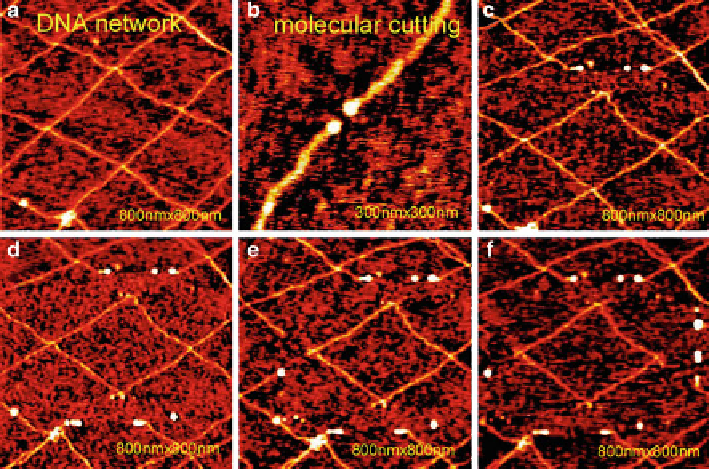Biomedical Engineering Reference
In-Depth Information
Fig. 5.1
(
a
) AFM image of a linear lambda DNA network on a mica surface. A molecular combing
technique was used to stretch and deposit the DNA molecules on the substrate. The image size is
800 nm
800 nm. (
b
) DNA strands were cut by an AFM tip with a sufficient load. The image size
is 300 nm
300 nm. (
c
-
f
) Molecular cutting of the DNA network resulted in a square pattern. The
image sizes are 800 nm
800 nm (Reprinted with the permission from Ref. [
13
]. Copyright 2002
American Chemical Society)
(dsDNA) varied for different AFM tips from 20 to 100 nN. After the DNA strands
were broken at the selected positions, the residuals were swept away, leaving a
predesigned pattern on the surface (Fig.
5.1
f). During sweeping, the AFM tip
scanned across the sample with a load smaller than the cutting threshold. It has
been found that DNA strands are highly elastic and can bear a large change in their
shape. Therefore, curved and wavy structures of individual DNA molecules can also
be constituted by a similar process based on the elastic behavior of DNA strands.
Linear DNA molecules can also be converted into spherical nanoparticles and
nanorods by AFM nanomanipulation. We found that DNA strand can be pushed
forward along the vertical scan direction of the AFM tip and folded up if we
start from the broken site and scan along the horizontal direction, i.e., nearly
perpendicular to the orientation of the DNA strands. The pushing operation can
be performed step by step at a precision of about 10 nm, depending on the tip
size. In this way, long DNA strands were folded up to form ordered nanostructures
(Fig.
5.2
).
In addition, our studies showed that nano-dissection of single-stranded DNA
(ssDNA) can also be performed in a controlled manner as that of dsDNA. However,
a comparison study indicated that ssDNA can be easily broken by the AFM tip than

Search WWH ::

Custom Search